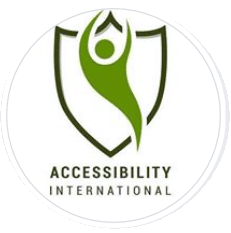The philosophy of Web Content Accessibility Guidelines (WCAG).
The United Nations has stated that access to information is a basic human right. This is the basic tenet of accessibility. All information, especially digital information, should be easily available to any person, regardless of ability or technology. Laws, standards, and guidelines outline how making information accessible is accomplished. The most widely accepted standards are the Web Content Accessibility Guidelines (WCAG). WCAG is an international set of rules developed by the World Wide Web Consortium (W3C) in order to provide a technical standard for web content accessibility. The W3C consists of members from around the world who contributed to the building of WCAG.
WCAG is accepted worldwide
These technical standards are based on four pillars of accessibility that define how information should be presented digitally. WCAG 2 are the standards adopted by the governments of Australia, Canada, France, Germany, Hong Kong, India, Italy, Ireland, Israel, Japan, Netherlands, New Zealand, Norway, Spain, UK, and the US to measure digital accessibility in your organization. WCAG 2.1 was released in June 2018 and builds upon the previous version without alteration to previous standards.
Overview of WCAG Pillars
According to WCAG, information that is presented digitally should be:
Perceivable
Operable
Understandable
Robust
Let’s discuss these pillars one by one.
Perceivable
This means that all information and functionality cannot be invisible or inaccessible to all of an individual’s senses. Thus far we have no way to smell or taste the internet. But until we do, users must be able to see or hear or feel the information being provided. This means that if content cannot be seen, it must be able to be heard or felt (for example, by using a connected Braille display). If it cannot be heard, it must be able to be seen or felt. All content must be able to be perceived and read by users, regardless of how they access the information (mouse, keyboard, screen reader, etc.). There should be a non-text alternative for all text and text functions. Some examples of “perceivable” include alt text for images and captions on videos, color contrast practices such as red text not being used against a green background (no matter how festive it feels) as 8% of men have red/green color blindness. Content should be easy to see or hear or feel with a connected Braille display, and it should be easy to locate.
Operable
This means the website should be functionally usable no matter how it is accessed. Buttons should work regardless of whether someone is using a keyboard, a mouse, a touchscreen, a joystick, or any other input mechanism. Users should be able to navigate through the content easily. The content should not produce seizures (for example from flashing lights or content) and should allow enough time for users to react to the information presented, even if their level of mobility makes them slow to respond. There should be no “keyboard traps” (places where you can tab onto an element but are unable to tab back out).
Understandable
This means the content must be understood by all users. It should not be so complex or difficult to read that users cannot use the information. It should not be overly technical. This is also common sense. If the information is too difficult to understand, users cannot make use of the website as intended and the purpose of the content will not be fulfilled. Example: forms should be clear and easy to fill in – terminology should be as clear as possible. Keep the names of objects (such as buttons, links, or other interactive elements) consistent when used in multiple locations. Don’t use “buy” in one place and “add to cart” in another–use one label for all identical functions. The language presented visually should be the same as the language coded into the website so that the screen reader is reading it in the correct language. I once saw a mistake in coding result in an unexpected change of language for screen reader users from English to French right in the middle of an exam.
Robust
The content should be usable with a variety of technologies, assistive and otherwise, and remain usable as technology changes. For example, a video should work regardless of the browser or device on which you are trying to watch it. Another example is that many websites simply do not function properly on a smartphone. Avoid content that is misplaced visually. Ensure fields can be accessed. Do not create settings that can only be reached via a right-click from a mouse. A mouse is a tool that someone accessing the content on a smartphone or using a screen reader may not be able to use.
WCAG as success criteria
The goal of WCAG is for your organization’s digital information to reach everyone, regardless of how they access that information. This means you need to remain familiar with both accessibility standards and changing technology. With one in four adults found in the CDC’s latest report to have a disability, you can be sure that a large part of your target audience has a need for accessible content in order to do business with your organization. Make accessibility an integral part of your organization. Allow it to mold how your digital content is created and provided to your audience.
The philosophy of these four pillars is the foundation of all success criteria in the web content accessibility guidelines.
They also cover more than the specific guidelines can: questions such as “what is simple language?” Simple to whom? In what context? If your online content meets these basic pillars of the WCAG philosophy, it will meet or exceed the individual standards found in WCAG.
Need to know more about WCAG and accessibility? Let us help!




